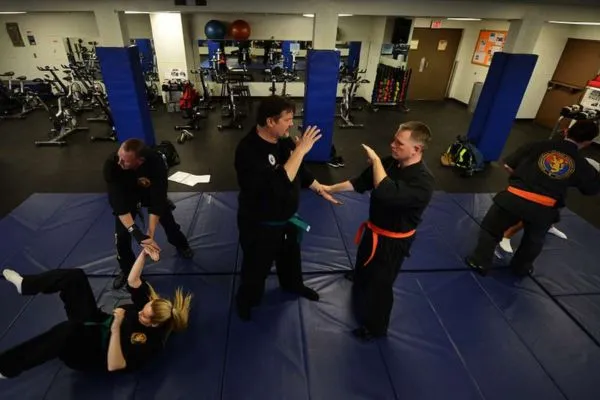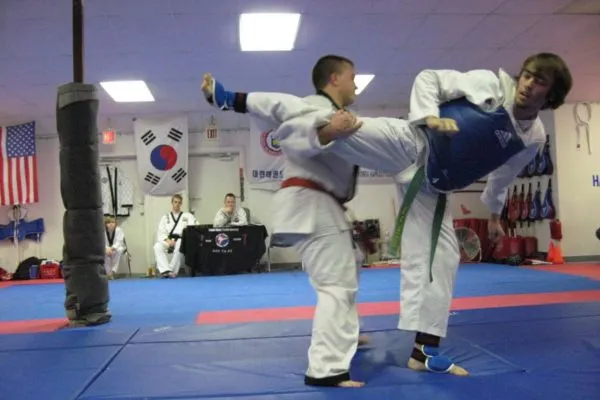“How long to get a black belt in Hapkido?” Many martial arts enthusiasts strive to master the art of self-defense and unlock their inner power. Among the myriad disciplines, Hapkido stands out for its seamless blend of dynamic strikes, grappling, and joint locks.
Delve into the captivating realm of Hapkido as we explore the path to achieving the coveted black belt and unveil the secrets of this incredible martial art.
Table of Contents
ToggleHow Long to Get a Black Belt in Hapkido
On average, earning a black belt in Hapkido takes three to five years of consistent training. However, this duration is not set in stone. Additionally, it can be influenced by factors like the frequency of activity, the intensity of practice, and the student’s proficiency.
Indeed, focusing on steady progress and enjoying the journey is essential rather than solely fixating on the end goal.
Undoubtedly, achieving a black belt in the art of Hapkido belts requires a lot of dedicated training and practice. Furthermore, it is important to remember that the time needed will differ depending on the individual’s commitment, talent, and the specific training program.
Related: Top 7 Hardest Martial Arts to Get a Black Belt. Find out here.
How Many Belt Levels Are There in Hapkido?
The number of belt levels in Hapkido can vary between schools and organizations. However, the most common progression includes a series of colored belts leading up to the black belt.
In general, Hapkido belt systems may consist of several colored belts, followed by various degrees of black belts. Here is a typical example:

White Belt
This belt is the starting point for beginners and symbolizes the beginning of the Hapkido journey. Nevertheless, hapkido white belt techniques usually consist of fundamentals that form the foundation of your training. Also, these techniques focus on basic strikes, kicks, joint locks, and self-defense movements.
Yellow Belt
After the white belt, a yellow belt is the first level of achievement that represents progress and the acquisition of basic skills. As you advance to a yellow belt, you can expect to develop your striking, kicking, joint locks, throws, and falls skills.
Moreover, this belt will allow you to learn new techniques and combinations and build upon your skills from previous belts.
Orange Belt
The orange belt is one of the beginner’s achievement belts which represent the growth of a practitioner. Other than that, a practitioner gets an orange belt when be het to learns 10 defensive moves.
Green Belt
This belt is the next advancement level, indicating further development and understanding of Hapkido techniques and principles.
Those who hold a green belt in Hapkido have likely mastered the basic moves and techniques of the art, such as joint locks, throws, strikes, and kicks. In addition to learning how to defend yourself, you may also know how to use Hapkido self-defense techniques.

Blue Belt
This belt signifies a higher level of proficiency and knowledge in Hapkido, showing progress towards more advanced levels. As a Combat Hapkido blue belt requirement, practitioners have achieved a solid foundation of fundamentals and techniques. Additionally, practitioners can certainly apply basic strikes, kicks, joint locks, and throws in controlled training scenarios effectively.
Purple Belt
A purple belt showcases the Brilliance of Selection. Getting a purple belt means you’re growing as a hapkido fighter and it shows in your skills and moves. Also, the purple belt is all about being an expert in advanced defensive techniques.
Brown Belt
The Brown belt is quite similar to the purple belt. Both of these belts mean you’re getting better at advanced training and defensive techniques.
Red Belt
The red belt represents significant expertise and experience in Hapkido, indicating that the practitioner is approaching advanced levels of the art.
A red belt student typically learns more advanced techniques, such as joint locks, throws, strikes, and self-defense. Also, they may focus on physical conditioning, flexibility, and understanding Hapkido’s philosophy.
Black Belt
In Hapkido, the black belt is the highest rank, symbolizing mastery and expertise. There are typically multiple degrees or dan within the black belt level, such as 1st dan, 2nd dan, and so on, indicating increasing skill and experience levels.
What is the Belt Order in Hapkido?
In Hapkido, the specific belt order may vary slightly depending on the organization or school you are training with. However, belt progression in Hapkido typically follows a color system that starts with a white belt and progresses through various colors. The exact colors and order may vary, but here is a commonly observed belt order in Hapkido:
- White Belt
- Yellow Belt
- Orange Belt
- Green Belt
- Blue Belt
- Purple Belt
- Brown Belt
- Red Belt
- Black Belt
In Hapkido, the black belt is not the final level of mastery. After achieving the first-degree black belt, practitioners can continue to advance through multiple degrees of black belt, typically indicated by stripes or degrees added to the belt. Additionally, the higher-degree black belts often require many years of dedicated practice and study.
What are the Combat Hapkido Black Belt Requirements?
Combat Hapkido is a modern and practical self-defense system focusing on real-world combat situations. Here are some general guidelines for Combat Hapkido black belt requirements:
Technical Proficiency:
A black belt candidate must demonstrate high technical proficiency in various Hapkido techniques, including strikes, kicks, joint locks, and throws.
Forms:
Combat Hapkido requires proficiency in several predetermined movements and transitions with predetermined techniques.
Self-Defense Techniques:
It is essential to master self-defense techniques in Combat Hapkido, such as grappling, striking, choking, and using weapons against different attacks.
Sparring and Drills:
When sparring with a training partner, you should demonstrate reasonable control, accuracy, and proficiency in applying your techniques.
Weapons Training:
Combat Hapkido black belt requirements may include weapon training, which involves learning and demonstrating proficiency with several traditional Korean weapons.
Knowledge and Theory:
An advanced black belt candidate should have comprehensive knowledge of body mechanics, pressure points, vital targets, and how to adapt techniques to different situations.
Conditioning and Fitness:
Candidates for black belt in Combat Hapkido are expected to demonstrate a high level of physical fitness, endurance, and flexibility.
Teaching Ability:
A black belt may be required to teach and assist lower-ranking students. Moreover, these skills include effective communication, coaching, and breaking down techniques and concepts.
As a cautionary note on how long to get a black belt in Hapkido, it is essential to remember that there may be differences in the specific requirements for black belt ranking in Combat Hapkido based on the school or organization.
Conclusion
So, to sum it up, Hapkido is a fantastic martial art that combines strikes, grappling, and joint locks for self-defense. How long to get a black belt in Hapkido varies, depending on dedication, training, and natural ability. But remember, it’s not just about time. That’s why, the journey to a black belt is about personal growth, discipline, and mastering the art. It’s a rewarding experience that’s worth every step.
Chris Bent
Chris Bent is a professional MMA Trainer who has expertise in both Martial Arts and Karate and he loves to teach Men, Women and Kids.